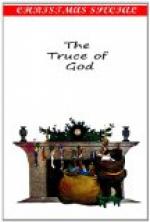At these words a smile beamed over her sharp features, and she sank gradually back in bed, lowered by Henry and the missionary.
The proud Lord of Hers was, in spirit, in sackcloth and ashes. He attributed the existence of the feud to his indiscretion and guilt, and reproached himself with all its pernicious consequences. He saw in the wreck before him the fruits of his sin; Bertha’s misery and madness seemed wholly his own unhallowed work. The strong man shuddered at the consequences of his folly, and beat his breast, and wept like a child.
Sandrit of Stramen also accused himself of having caused the feud by his rash credulity, and driven Bertha to perjury and insanity by his impetuous and uncontrollable temper. For, he reasoned, had she reposed any confidence in his justice and charity, she would have told the truth.
Henry of Stramen saw that all his brilliant achievements against the family of Hers were only unjustifiable murders and robberies, and his haughty spirit was humbled and contrite.
Father Omehr saw their contrition, but he was entirely absorbed in the penitent Bertha.
Bertha lived three days after the revelation, constantly engaged in prayer and acts of contrition. Her profound sorrow affected and edified the missionary and all the neighborhood. On the third day she received the Viaticum, and expired in the arms of the Baron of Stramen, who, together with the Lord of Hers, had repeatedly assured her of their complete forgiveness. Her last words were: “I know she is praying for me in heaven.”
She was buried, as she desired, near the Lady Margaret, with nothing but a rude wooden cross to mark her grave.
On the day after her burial, Father Omehr and the three nobles set out for the Castle of Hers. Humbert had already fitted up for his lord some rooms which had been only partially consumed, and Albert of Hers had prevailed upon the baron and his son to remain with him until they could find suitable lodgings at home. The reconciliation between the nobles was complete; and at sunrise the next day they could be seen kneeling together before the altar of the Pilgrim’s Chapel, eating the Bread of Life. If the Angels rejoice at such a sight, how much greater must be the joy of the Saints!
But where was Gilbert, that he could not share in the blessed feast?
The Middle Ages abound in characters better entitled to our consideration and esteem than the classic magnates of Greece and Rome. There is not in pagan antiquity such a combination of virtue, constancy, fortitude, and valor as was presented in Matilda of Tuscany, “the heroine of the Middle Ages.” She devoted herself to the cause of the Holy See as early as 1604, and her life was a series of sacrifices cheerfully made for the security of the Church. While wondering at her heroism, you love her for her charity, and revere her for her piety. Let Catholics read her life, and they will embalm her in their hearts. Her unvarnished actions are a nobler eulogy than even the unfading wreath flung by a master’s hand on the grave of the martyred Marie Antoinette.




